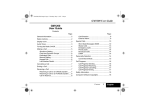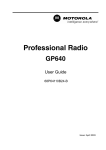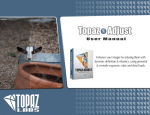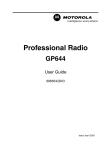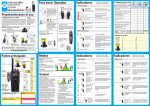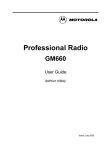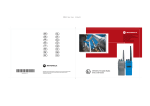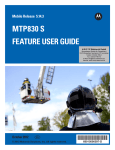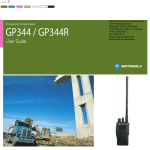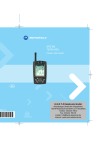Download Neo Display User Guide 1.6
Transcript
PROFESSIONAL DIGITAL TWO-WAY RADIO SYSTEM MOTOTRBO™ DP 3400/DP 3401 MPT1327 FOR PORTABLE RADIOS USER GUIDE Authorized Communication Solution Provider H.E.R.T.Z Elektronik GmbH Strausberger Straße 8h (Pappelhain) 15378 Rüdersdorf bei Berlin (OT Herzfelde) Telefon: 033434 766-0 Fax: 033434 766-76 E-Mail: [email protected] Internet: www.hertz-elektronik.de EMEA_NonDispPort.book Page i Friday, June 10, 2011 2:24 PM Contents Important Safety Information . . . . . . . . . . . . . . . . . iii Product Safety and RF Exposure Compliance . . .iii Software Version . . . . . . . . . . . . . . . . . . . . . . . . . . . iii Option Board Part Number . . . . . . . . . . . . . . . . . . . iii Computer Software Copyrights . . . . . . . . . . . . . . . iv Identifying Radio Controls . . . . . . . . . . . . . . . . . . . . 6 Radio Controls . . . . . . . . . . . . . . . . . . . . . . . . . . . . . 7 Programmable Buttons . . . . . . . . . . . . . . . . . . . . . . . 8 Assignable Radio Functions . . . . . . . . . . . . . . . . . 8 Identifying Status Indicators . . . . . . . . . . . . . . . . . . . 9 LED Indicators . . . . . . . . . . . . . . . . . . . . . . . . . . . . . 9 Audio Tones . . . . . . . . . . . . . . . . . . . . . . . . . . . . . . . 9 Indicator Tones . . . . . . . . . . . . . . . . . . . . . . . . . . . . 10 Getting Started . . . . . . . . . . . . . . . . . . . . . . . . . . . . . . 1 How to Use This User Guide . . . . . . . . . . . . . . . . . . 1 What Your Dealer/System Administrator Can Tell You . . . . . . . . . . . . . . . . . . . . . . . . . . . . . . 1 Additional Performance Enhancement . . . . . . . . . . 2 Tone Private Line (TPL) . . . . . . . . . . . . . . . . . . . . . 2 MPT Personality and Radio Zones . . . . . . . . . . . . . 10 MPT . . . . . . . . . . . . . . . . . . . . . . . . . . . . . . . . . . . . 11 Talkgroup . . . . . . . . . . . . . . . . . . . . . . . . . . . . . . . . 11 Fixed and Dynamic Groups . . . . . . . . . . . . . . . . . 11 Announcement Group . . . . . . . . . . . . . . . . . . . . . 11 Personality Selection . . . . . . . . . . . . . . . . . . . . . . . 12 Zone Selection . . . . . . . . . . . . . . . . . . . . . . . . . . . . 12 Preparing Your Radio for Use . . . . . . . . . . . . . . . . . . 2 Charging the Battery . . . . . . . . . . . . . . . . . . . . . . . . . 2 Attaching the Battery . . . . . . . . . . . . . . . . . . . . . . . . . 3 Attaching the Antenna . . . . . . . . . . . . . . . . . . . . . . . . 4 Attaching the Belt Clip . . . . . . . . . . . . . . . . . . . . . . . . 4 Attaching the Universal Connector Cover (Dust Cover) 5 Radio Calls . . . . . . . . . . . . . . . . . . . . . . . . . . . . . . . . 13 Making a Call . . . . . . . . . . . . . . . . . . . . . . . . . . . . . 13 Dedicated Calls . . . . . . . . . . . . . . . . . . . . . . . . . . 13 Contact List . . . . . . . . . . . . . . . . . . . . . . . . . . . . . 14 Last Number Redial . . . . . . . . . . . . . . . . . . . . . . . 14 Receiving a Call . . . . . . . . . . . . . . . . . . . . . . . . . . . 15 Contents This User Guide covers only the functional operation of the MPT1327 Generic Option Board (GOB) installed in MOTOTRBO Series Portables. Powering Up the Radio . . . . . . . . . . . . . . . . . . . . . . . 5 Adjusting the Volume . . . . . . . . . . . . . . . . . . . . . . . . 6 i English EMEA_NonDispPort.book Page ii Friday, June 10, 2011 2:24 PM Receiving a Call on an OACSU System . . . . . . . Receiving a Call on a FOACSU System . . . . . . . Cancelling a Call . . . . . . . . . . . . . . . . . . . . . . . . . . Ending a Call . . . . . . . . . . . . . . . . . . . . . . . . . . . . . Missed Calls . . . . . . . . . . . . . . . . . . . . . . . . . . . . . . Deleting Missed Call List . . . . . . . . . . . . . . . . . . . Call Diversion . . . . . . . . . . . . . . . . . . . . . . . . . . . . . Emergency Calls . . . . . . . . . . . . . . . . . . . . . . . . . . 15 15 15 15 16 16 17 17 Notes Notes . . . . . . . . . . . . . . . . . . . . . . . . . . . . . . . . . . . . . 17 ii English Notes EMEA_NonDispPort.book Page iii Friday, June 10, 2011 2:24 PM Software Version Product Safety and RF Exposure Compliance All the features described in the following sections are supported by the radio's software version R01.08.20 or later. ! Caution Before using this product, read the operating instructions for safe usage contained in the Product Safety and RF Exposure booklet enclosed with your radio. Check with your dealer or system administrator for more details of all the features supported. Option Board Part Number ATTENTION! This radio is restricted to occupational use only to satisfy FCC/ICNIRP RF energy exposure requirements. Before using this product, read the RF energy awareness information and operating instructions in the Product Safety and RF Exposure booklet enclosed with your radio (Motorola Publication part number 6864117B25) to ensure compliance with RF energy exposure limits. All the features described in the following sections are supported by the radio’s MPT1327 Generic Option Board kit number PMLN5743_S. Important Safety Information Important Safety Information For a list of Motorola-approved antennas, batteries, and other accessories, visit the following website: http://www.motorola.com/governmentandenterprise iii English EMEA_NonDispPort.book Page iv Friday, June 10, 2011 2:24 PM Computer Software Copyrights Computer Software Copyrights The Motorola products described in this manual may include copyrighted Motorola computer programs stored in semiconductor memories or other media. Laws in the United States and other countries preserve for Motorola certain exclusive rights for copyrighted computer programs including, but not limited to, the exclusive right to copy or reproduce in any form the copyrighted computer program. Accordingly, any copyrighted Motorola computer programs contained in the Motorola products described in this manual may not be copied, reproduced, modified, reverse-engineered, or distributed in any manner without the express written permission of Motorola. Furthermore, the purchase of Motorola products shall not be deemed to grant either directly or by implication, estoppel, or otherwise, any license under the copyrights, patents or patent applications of Motorola, except for the normal non-exclusive license to use that arises by operation of law in the sale of a product. iv English The AMBE+2TM voice coding Technology embodied in this product is protected by intellectual property rights including patent rights, copyrights and trade secrets of Digital Voice Systems, Inc. This voice coding Technology is licensed solely for use within this Communications Equipment. The user of this Technology is explicitly prohibited from attempting to decompile, reverse engineer, or disassemble the Object Code, or in any other way convert the Object Code into a human-readable form. U.S. Pat. Nos. #5,870,405, #5,826,222, #5,754,974, #5,701,390, #5,715,365, #5,649,050, #5,630,011, #5,581,656, #5,517,511, #5,491,772, #5,247,579, #5,226,084 and #5,195,166. EMEA_NonDispPort.book Page 1 Friday, June 10, 2011 2:24 PM Getting Started How to Use This User Guide This User Guide covers only the functional operation of the MPT1327 Generic Option Board (GOB) installed in MOTOTRBO Portables. For the complete operation of the MOTOTRBO Portables, refer to the specific User Guides for each radio. You can consult your dealer or system administrator about the following: • Is your radio programmed with any preset conventional channels? • Which buttons have been programmed to access other features? • What optional accessories may suit your needs? Getting Started Take a moment to review the following: How to Use This User Guide . . . . . . . . . . . . . . . . . . . . . page 1 What Your Dealer/System Administrator Can Tell You . page 1 Additional Performance Enhancement . . . . . . . . . . . . . page 2 What Your Dealer/System Administrator Can Tell You NOTE: Specifications may vary for different radio models. Check with your dealer or system administrator for more information. 1 English EMEA_NonDispPort.book Page 2 Friday, June 10, 2011 2:24 PM Additional Performance Enhancement The following are some of the latest creations designed to enhnace the security, quality and efficiency of your radio. Preparing Your Radio for Use Tone Private Line (TPL) TPL prevents any channel or radio out of MPT system to disturb the transmission in MPT system. TPL code are embedded in the traffic channels to prevent noise when the radio is receiving TPL voice or data signals. To run this feature fully, your MPT base station and radios need to be enabled to receive and transmit TPL signals. Only the radios with TPL feature enabled are able to encode or decode the TPL signal. 2 English Preparing Your Radio for Use Assemble your radio by following these steps: Charging the Battery . . . . . . . . . . . . . . . . . . . . . . . . . . . page 2 Attaching the Battery . . . . . . . . . . . . . . . . . . . . . . . . . . . page 3 Attaching the Antenna . . . . . . . . . . . . . . . . . . . . . . . . . . page 4 Attaching the Belt Clip . . . . . . . . . . . . . . . . . . . . . . . . . . page 4 Attaching the Universal Connector Cover (Dust Cover) . . . . . . . . . . . . . . . . . . . . . . . . . . . . page 5 Powering Up the Radio . . . . . . . . . . . . . . . . . . . . . . . . . page 5 Adjusting the Volume . . . . . . . . . . . . . . . . . . . . . . . . . . . page 6 Charging the Battery Your radio is powered by a Nickel Metal-Hydride (NiMH) or Lithium-Ion (Li-lon) battery. To avoid damage and comply with warranty terms, charge the battery using a Motorola charger exactly as described in the charger user guide. Charge a new battery for 14 to 16 hours before initial use for best performance. EMEA_NonDispPort.book Page 3 Friday, June 10, 2011 2:24 PM Attaching the Battery Battery Latch Preparing Your Radio for Use To remove the battery, turn the radio off. Move the battery latch into unlock position and hold, and slide the battery down and off the rails. Align the battery with the rails on the back of the radio. Press the battery firmly, and slide upward until the latch snaps into place. Slide battery latch into lock position. 3 English EMEA_NonDispPort.book Page 4 Friday, June 10, 2011 2:24 PM Attaching the Antenna Preparing Your Radio for Use With the radio turned off, set the antenna in its receptacle and turn clockwise. Attaching the Belt Clip Align the grooves on the clip with those on the battery and press downward until you hear a click. To remove the clip, press the belt clip tab away from the battery using a key. Then slide the clip upward and away from the radio. To remove the antenna, turn the antenna counterclockwise. Make sure you turn off the radio and remove the universal connector cover (dust cover) first. ! Caution 4 English If antenna needs to be replaced, ensure that only MOTOTRBO antennas are used. Neglecting this damages your radio. EMEA_NonDispPort.book Page 5 Friday, June 10, 2011 2:24 PM Attaching the Universal Connector Cover (Dust Cover) Cover (Dust Cover) Insert the hooked end of the cover into the slots above the universal connector. Press downward on the cover to seat the lower tab properly into the RF connector. Turn the thumbscrew clockwise to secure the connector cover to the radio. Replace the dust cover when the universal connector is not in use. Powering Up the Radio Rotate the On/Off/Volume Control Knob clockwise until you hear a click. The LED blinks green. A brief tone sounds, indicating that the power up test is successful. If your radio does not power up, check your battery. Make sure that it is charged and properly attached. If your radio still does not power up, contact your dealer. Preparing Your Radio for Use The universal connector is located on the antenna side of the radio. It is used to connect MOTOTRBO accessories to the radio. Place the universal connector cover loop over the attached antenna. Slide it all the way down to the Universal base of the antenna. Connector To remove the universal connector cover, press down on the cover and turn the thumbscrew counterclockwise. Lift the cover up, slide the connector cover loop upwards, and remove it from the attached antenna. To turn off the radio, rotate this knob counterclockwise until you hear a click. 5 English EMEA_NonDispPort.book Page 6 Friday, June 10, 2011 2:24 PM Adjusting the Volume To increase the volume, turn the On/Off/Volume Control Knob clockwise. Identifying Radio Controls To decrease the volume, turn this knob counterclockwise. NOTE: Your radio can be programmed to have a minimum volume offset where the volume level cannot be turned down fully. Check with your dealer or system administrator for more information. 6 English Identifying Radio Controls Take a moment to review the following: Radio Controls . . . . . . . . . . . . . . . . . . . . . . . . . . . . . . . . page 7 Programmable Buttons . . . . . . . . . . . . . . . . . . . . . . . . . page 8 EMEA_NonDispPort.book Page 7 Friday, June 10, 2011 2:24 PM Radio Controls 5 Push-to-Talk (PTT) Button 8 6 Side Button 2* 2 9 10 3 4 11 5 12 7 Side Button 3* 8 Antenna 9 Emergency Button* 10 Speaker 11 Universal Connector for Accessories 12 Microphone 6 7 * These buttons are programmable. Identifying Radio Controls 1 4 Side Button 1* 1 Channel Selector Knob 2 On/Off/Volume Control Knob 3 LED Indicator 7 English EMEA_NonDispPort.book Page 8 Friday, June 10, 2011 2:24 PM Programmable Buttons The Customer Programming Software (CPS) can program the programmable buttons as shortcuts to radio functions or preset channels/groups depending on the duration of a button press: • Short press – Pressing and releasing rapidly (between 0.05 and 0.75 second). Identifying Radio Controls • Long press – Pressing and holding for the programmed duration (between 1.00 second and 3.75 seconds). • Hold down – Keeping the button pressed. 8 English Assignable Radio Functions Clear – Allows cancelling an incoming or outgoing call (Only available on Side Button 1). Dedicated Call/Emergency/Help – To make a call to a predetermined number, effectively activating an Emergency, Priority, Speech, Status, Data, or a normal call. Personality – Shortcut to the personality menu option to select one of four MPT personalities (provided by MPT1327 GOB) or Conventional Zones (provided by TRBO radio). Help Call – Call the Help number as predefined via the CPS. SFD/Talkgroup Toggling – Press to toggle between SFD and Talkgroup mode. EMEA_NonDispPort.book Page 9 Friday, June 10, 2011 2:24 PM Identifying Status Indicators LED Indicators The LED indicator shows the operational status of your radio. Blinking red – Channels are currently busy. Blinking green – No service. Audio Tones Alert tones provide you with audible indications of the radio’s status or the radio’s response to data received. Continuous Tone A monotone sound. Sounds continuously until termination. Repetitive Tone LED Indicator A single tone that repeats itself until it is terminated by the user. Momentary Tone Sounds only once for a short period of time defined by the radio. Identifying Status Indicators Your radio indicates its operational status through the following: LED Indicators . . . . . . . . . . . . . . . . . . . . . . . . . . . . . . . . page 9 Audio Tones. . . . . . . . . . . . . . . . . . . . . . . . . . . . . . . . . . page 9 Indicator Tones . . . . . . . . . . . . . . . . . . . . . . . . . . . . . . page 10 Solid red – Radio is transmitting. 9 English EMEA_NonDispPort.book Page 10 Friday, June 10, 2011 2:24 PM Indicator Tones High pitched tone MPT Personality and Radio Zones Low pitched tone MPT Personality and Radio Zones Positive Indicator Tone 10 English Negative Indicator Tone Use this guide to understand the personalities programmed into your radio: MPT . . . . . . . . . . . . . . . . . . . . . . . . . . . . . . . . . . . . . . . page 11 Talkgroup . . . . . . . . . . . . . . . . . . . . . . . . . . . . . . . . . . . page 11 Personality Selection . . . . . . . . . . . . . . . . . . . . . . . . . . page 12 Zone Selection. . . . . . . . . . . . . . . . . . . . . . . . . . . . . . . page 12 The personalities described below are programmed into your radio by your dealer and are accessible either via the personality button or via the menu. An MPT personality contains data such as frequencies, display text, alert tones, permitted calls etc. which determines the mode of operation of your radio. Your radio may be programmed with up to 4 different MPT personalities. EMEA_NonDispPort.book Page 11 Friday, June 10, 2011 2:24 PM MPT Talkgroup Incoming calls to fixed and dynamic group numbers are detailed in Receiving a Call and displayed under Receiving a Call. To make an outgoing call to a selected talkgroup, press the PTT and speak after the Talk Permit Tone. Calls are cleared in the normal manner. Talkgroup is an MPT personality following the same rules or protocol, but is primarily for talkgroup calls. In talkgroup personality, talkgroups are contained in a Talkgroup list, similar to the Contact list, which is scrolled and selected using the Channel Selector Knob. On selection of a talkgroup, you may send and receive calls as described below. If the system is busy, an engaged tone will be heard, release the PTT and wait for the Talk Permit Tone. You may then proceed with the call by pressing the PTT. Fixed and Dynamic Groups Announcement Group These groups form part of the Talkgroup Personality, such that when this personality is selected your talkgroup list shows only these groups. The users which in an announcement group could receive this announcement group despite their radio is in any of the talkgroup. A fixed group is a group of users, the address (number) of which is preprogrammed into your radio by your dealer. The radio supports up to 15 announcement group entries. When in Talkgroup personality, you can still make an individual or status call using the keypad or entering the Contact List via the menu. See “Contact List” on page 14. MPT Personality and Radio Zones This personality permits the radio to operate in a trunked mode. Incoming and outgoing calls are set up using a defined set of rules or protocol between your radio and a controller in a similar manner to your home telephone. Therefore at any time you may become a member of a dynamic group, able to receive calls and (depending on how your radio is programmed) send calls to that group. A dynamic group is a group of users, the address (number) of which is sent to your radio ‘over air’ at any time via the system controller. 11 English EMEA_NonDispPort.book Page 12 Friday, June 10, 2011 2:24 PM Personality Selection The Personality menu provides access to all MPT personalities and radio defined zones. MPT Personality and Radio Zones Use the following procedure to select a personality. Procedure: 1 Ensure radio is in IDLE STATE. 2 Press the preprogrammed Personality button. You hear a positive indicator tone, indicating the radio has switched from non-MPT mode to MPT mode. OR You hear a negative indicator tone, indicating the radio has switched from MPT mode to non-MPT mode. 12 English Zone Selection A zone is a group of channels. Your radio supports up to 250 zones, with a maximum of 16 channels and Capacity Plus personalities per zone. Use the following procedure to select a zone. Procedure: 1 Ensure radio is in IDLE STATE. 2 Press the preprogrammed button (for zone). You hear a positive indicator tone, indicating the radio has switched from Zone 1 to Zone 2. OR You hear a negative indicator tone, indicating the radio has switched from Zone 2 to Zone 1. EMEA_NonDispPort.book Page 13 Friday, June 10, 2011 2:24 PM Radio Calls Use this navigation guide to familiarize yourself with the basic Call features: Making a Call. . . . . . . . . . . . . . . . . . . . . . . . . . . . . . . . page 13 Receiving a Call. . . . . . . . . . . . . . . . . . . . . . . . . . . . . . page 15 Cancelling a Call . . . . . . . . . . . . . . . . . . . . . . . . . . . . . page 15 Ending a Call . . . . . . . . . . . . . . . . . . . . . . . . . . . . . . . . page 15 Missed Calls . . . . . . . . . . . . . . . . . . . . . . . . . . . . . . . . page 16 Call Diversion . . . . . . . . . . . . . . . . . . . . . . . . . . . . . . . page 17 Emergency Calls . . . . . . . . . . . . . . . . . . . . . . . . . . . . . page 17 The radio is capable of making a variety of calls, including calls to individual radios, groups of radios and calls to private and public telephone systems. Before you can make a call the radio must be in IDLE STATE, i.e. a personality has been selected and no call is in progress. The radio can make calls by using the Dedicated Calls or Contact List. Radio Calls Once you understand how your MOTOTRBO Portable is configured, you are ready to use your radio. Making a Call Dedicated Calls Dedicated calls can be made from either a preprogrammed button (for Dedicated Call). Press the preprogrammed button (for Dedicated Call) to make a call to the most commonly used preprogrammed number. The call may also be programmed as an Emergency Call, Priority Call or Status Call. 13 English EMEA_NonDispPort.book Page 14 Friday, June 10, 2011 2:24 PM Contact List The contact list allows access to up to 16 preprogrammed numbers using the Channel Selector Knob. Procedure: Last Number Redial To make a call using contact list: The last number dialed by the radio is stored in the memory of the radio. 1 Ensure radio is in IDLE STATE. 2 Turn the Channel Selector Knob to select the required contact. 3 Press PTT button to initiate radio call. The radio sends out its ID and sounds a tone. 4 Hold the radio vertically 1 to 2 inches (2.5 to 5.0 cm) from your mouth. 5 Press PTT button to make the call. 6 Wait for the Talk Permit Tone to finish (if enabled) and speak Radio Calls If a contact list number is selected but no call request is sent, the radio is held until a momentary tone sounds and then reverts to the IDLE STATE. clearly into the microphone. 7 Release the PTT button to listen. 8 If there is no voice activity for a predetermined period of time, the call ends. OR Press preprogrammed button (for Clear) to end a call. A momentary tone sounds. 14 English Procedure: To redial last number: 1 Ensure radio is in IDLE STATE. 2 Press the preprogrammed button (redial key) to make the call. The radio sends out its ID and sounds a tone. 3 Hold the radio vertically 1 to 2 inches (2.5 to 5.0 cm) from your mouth. 4 Wait for the Talk Permit Tone to finish (if enabled) and speak clearly into the microphone. 5 If there is no voice activity for a predetermined period of time, the call ends. OR Press preprogrammed button (for Clear) to end a call. A momentary tone sounds. Last number redial does not function when Talkgroup personality is selected. See “Talkgroup” on page 11. EMEA_NonDispPort.book Page 15 Friday, June 10, 2011 2:24 PM Receiving a Call If you are in doubt about which system you are operating on, please consult your dealer. Receiving a Call on an OACSU System When the radio is called: 1 A repetitive tone sounds. The red LED lights up. Call is being set up. 2 A momentary tone sounds. The call ends. At any time while setting up a call it may be cancelled. To cancel a call: 1 Press preprogrammed (for Clear) button. A repetitive tone sounds. Ending a Call Radio Calls There are two types of systems on which the radio may be used, Off Air Call Set Up (OACSU) and Full Off Air Call Set Up (FOACSU). Cancelling a Call At any time while a call is in progress it may be ended. To end a call: 1 Press preprogrammed (for Clear) button. A repetitive tone sounds. Receiving a Call on a FOACSU System When the radio is called: 1 The ring tone sounds. The red LED lights up. 2 Press the PTT button to accept call (unless in talkgroup personality, when radio unmutes automatically for fixed and dynamic group calls). 3 A repetitive tone sounds. The red LED lights up. Call is being set up. 4 A momentary tone sounds. The call ends. 15 English EMEA_NonDispPort.book Page 16 Friday, June 10, 2011 2:24 PM Missed Calls If a call remains unanswered, the call is stored by the radio, provided that missed calls have been programmed into your radio. Only one call can be stored. If the same radio calls more than once the call is only stored once. When the calls have been stored by the radio, any further calls received overwrite the stored call. When a call has been stored by the radio, a momentary tone sounds every ten seconds. The Missed Call List can also be entered directly by pressing the Missed Call button (if programmed) when the radio is in the IDLE STATE. Calling Missed Call List Radio Calls To make a call back to the number in the Missed Call list: 5 Release the PTT button to listen. 6 If there is no voice activity for a predetermined period of time, the call ends. OR Press preprogrammed button (for Clear) to end a call. A momentary tone sounds. Deleting Missed Call List On a successful call setup, the entry is automatically deleted from the stack and the radio returns to the IDLE STATE. An unanswered call may be deleted from the Missed Call list at any time. To delete a number in the Missed Call List: 1 Ensure radio is in IDLE STATE. 2 Press preprogrammed button (for Missed Calls). 1 Ensure radio is in IDLE STATE. 3 Press preprogrammed button (for Clear). 2 Press the PTT button to make the call. The radio sends out NOTE: The calls in the stack are not deleted when the radio is turned off. It is not possible to call back status calls. its ID and sounds a tone. 3 Hold the radio vertically 1 to 2 inches (2.5 to 5.0 cm) from your mouth. 4 Wait for the Talk Permit Tone to finish (if enabled) and speak clearly into the microphone. 16 English EMEA_NonDispPort.book Page 17 Friday, June 10, 2011 2:24 PM Call Diversion Call diversion and cancellation may be programmed into the Contact List. Please contact your network manager or dealer for further information. Notes Notes Incoming speech calls or status calls can be diverted from your radio or to your radio. Emergency Calls An emergency call allows you the highest form of priority calling and normally takes precedence over all other calls. Your radio can be programmed to give you a one-button quick access to call a particular radio or centre (predefined by your dealer) in emergency situations. Procedure: To initiate an emergency call: 1 Press the Emergency button. A repetitive tone sounds. Emergency can be stopped by one of the following: • Switching the radio Off and On again. • The emergency time duration is reached. NOTE: The emergency time duration is programmed into your radio by your dealer. Your radio may receive an emergency call when a repetitive tone sounds. 17 English MOTOROLA, MOTO, MOTOROLA SOLUTIONS and the Stylized M logo are trademarks or registered trademarks of Motorola Trademark Holdings, LLC and are used under license. All other trademarks are the property of their respective owners. © 2011 Motorola Solutions, Inc. All rights reserved. June 2011. www.motorola.com/mototrbo *68012003014* 68012003014-B


























